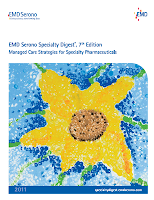 This week's latest data on the specialty market comes from the 2011 edition of the EMD Serono Specialty Digest™, a timely and useful report on payer and managed care strategies for specialty drugs. The report is free, but has a bizarre registration process. (Why exactly do I need a super-secret password to download a free report?)
This week's latest data on the specialty market comes from the 2011 edition of the EMD Serono Specialty Digest™, a timely and useful report on payer and managed care strategies for specialty drugs. The report is free, but has a bizarre registration process. (Why exactly do I need a super-secret password to download a free report?)The results provide intriguing fact-based insights about specialty channels, benefits, and commercial models. A few highlights:
- There is no consensus among plan sponsors on how to define a drug as a “specialty pharmacy” product.
- Benefit coverage, patient out-of-pocket costs, and reimbursement methods for specialty drugs are all over the place.
- Plan sponsors have not yet settled on the best way to manage specialty drugs.
Let me offer a hearty Drug Channels "Thank You" to EMD Serono for again sponsoring this research. Read on for my quick tour through the weird and wonderful world of specialty drugs!
THE DATA
This year’s report is based on responses from 93 health plans representing more than 115 million covered lives across the following spectrum of plan types:
- 70.1 million commercial lives (healthcare maintenance organization or preferred provider organization)
- 16.5 million Medicare Advantage prescription drug plan lives
- 14.0 million managed Medicaid lives
- 15.1 million other (unspecified) lives
Two warnings before you interpret the results:
- Each plan has equal weight in the results. In other words, a national plan with 2 million lives has the same weight in the results as a regional plan with 200,000 lives. Keep this computation issue in mind before overgeneralizing the results. I would have preferred to see the results weighted by number of covered lives as in The 2010 ICORE Healthcare Medical Injectables & Oncology Trend Report.
- Be skeptical of the time trends (2008 vs. 2009 vs. 2010) because the sample base continues to shift over time. The 2008 data are based on responses from 69 health plans with only 83 million covered lives. The 2009 data are based on 85 health plans with 120 million covered lives. For some reason, the percentage of commercial lives in the sample has dropped from 82% (2008) to 74% (2009) to 61% (2010).
Contrary to popular belief, state boards of pharmacy do not have unique regulatory requirements that define a “specialty pharmacy” versus some other kind of pharmacy. What factors do plan sponsors consider?
I was very surprised to see the lack of agreement for the items in the EMD survey. The questions are a bit vague for my taste. (What is “Special Handling” and did every respondent use the same definition?)
Note that only 2 of the 9 criteria received a majority of votes. The average answer to "high cost" was $1,200 per month. (Click the chart to enlarge.)
 THE BENEFIT MUDDLE
THE BENEFIT MUDDLEUnlike traditional oral drugs, a specialty drug can be covered under a medical benefit, a pharmacy benefit, both medical and pharmacy, or a standalone specialty benefit. The summary data on coverage by provider appears in Figure 7 on page 21. However, I found the data on benefit coverage of individual specialty therapy categories to be really interesting. These data are (directionally) comparable to the last two columns of Exhibit 13 from the most recent Express Scripts drug trend report.
 Some implications of the benefit muddle:
Some implications of the benefit muddle:- Out-of-pocket costs can vary dramatically between medical and pharmacy benefit. Fixed dollar co-pays are most common under the pharmacy benefit, while % coinsurance is most common under the medical benefit. (See Figure 11 on page 25.) Only 17% of plans try to maintain equal cost across benefits.
- Provider reimbursement methodologies are vastly different. Specialty drugs paid under a medical benefit are most likely to be based on Average Sales Price (ASP), while specialty drugs paid under a pharmacy benefit are most likely to be based on Average Wholesale Price (AWP). See Figure 12 on page 28. In theory, the same drug treating the same patient for the same condition will be reimbursed by the plan at two different rates.
- Plans have less visibility on specialty drug spending paid by a medical benefit. However, it’s getting better if you believe the time trend data in Figure 10 on page 24.
These are not theoretical issues. Specialty drug trend—the change in annual per-member costs for the plan sponsor—is going up by about 16-17% per year. (See Is Caremark really better at managing drug trend?)
So, what are plans doing? This year’s report has an interesting question on plan sponsor strategies for managing across the pharmacy and medical benefit. (See Figure 9 on page 23.) There are only two common practices:
- Clinical criteria that cover the entire therapy category across benefits
- Pharmacy department manages specialty Prior Authorization (PA) across benefits
YOUR TURN
My consulting focus is on biopharmaceutical manufacturers, so these data spark me to consider many interesting questions about contracting, trade, and channel strategies. Alas, I must refrain from listing these items here since my competitors read and utilize Drug Channels.
Nonetheless, I think it should be pretty clear that anyone in the drug channels system—manufacturers, wholesalers, pharmacies, plan sponsors, PBMs, GPOs—can learn from the data in the EMD report and the questions implied about how the specialty market will evolve.

No comments:
Post a Comment